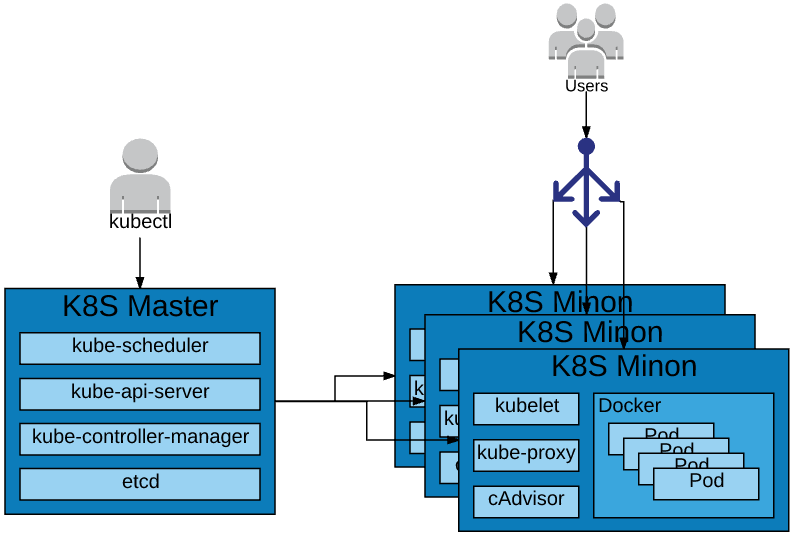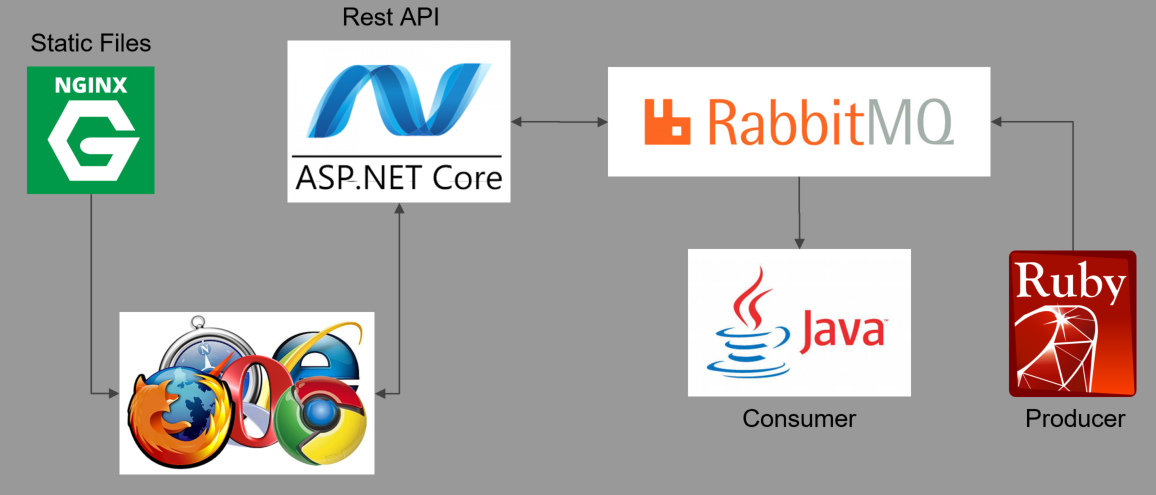Zero to DevOps in
Under an Hour with

http://slides.com/dalealleshouse/kube

Who is this guy?
Dale Alleshouse
@HumpbackFreak
hideoushumpbackfreak.com
github.com/dalealleshouse
Agenda
-
What is Kubernetes?
-
Kubernetes Goals
-
Kubernetes Basic Architecture
-
Awesome Kubernetes Demo!
-
What Now?
What is Kubernetes?
- AKA K8S
- Greek for Ship's Captain (κυβερνήτης)
- Google's Open Source Container Management System
- https://github.com/kubernetes
- Lessons Learned from Borg/Omega
- K8S is speculated to replace Borg
- Released June 2014
- 1.0 Release July, 2015
- Currently in Version 1.6
- Highest Market Share
K8S Goals
- Container vs. VM Focus
- Portable (Run everywhere)
- General Purpose
- Any workload - Stateless, Stateful, batch, etc...
- Flexible (consume wholesale or a la carte)
- Extensible
- Automatable
- Advance the state of the art
- cloud-native and DevOps Focused
- mechanisms for slow monolith/legacy migrations
K8S Architecture

More Architecture Info
- Omega: flexible, scalable schedulers for large compute clusters
- https://research.google.com/pubs/pub41684.html
- Large-scale cluster management at Google with Borg
- https://research.google.com/pubs/pub43438.html
- Borg, Omega, and Kubernetes
- https://research.google.com/pubs/pub44843.html
- https://github.com/kubernetes/community
Demo System

https://github.com/dalealleshouse/zero-to-devops
Setup
- Cluster
- Minikube
- Ingress
- Load Balancers
- Hosts File
- Docker Registry
Deployments
- Deployments consist of pods and replica sets
- Pod - One or more containers in a logical group
- Replica set - controls number of pod replicas
# Create a deployment for each container in the demo system
kubectl run html-frontend --image=html-frontend:1.0 --port=80 --env STATUS_HOST=status.demo.com
kubectl run java-consumer --image=java-consumer:1.0
kubectl run ruby-producer --image=ruby-producer:1.0
kubectl run status-api --image=status-api:1.0 port=5000
kubectl run queue --image=rabbitmq:3.6.6-management
# View the pods created by the deployments
kubectl get pods
# Run docker type commands on the containers
kubectl exec -it *POD_NAME* bash
kubectl logs *POD_NAME*Services
Services provide a durable end point
# Notice the java-consumer cannot connect to the queue
kubectl get logs *java-consumer-pod*
# The following command makes the queue discoverable via the name queue
kubectl expose deployment queue --port=15672,5672 --name=queue
# Running the command again shows that it is connected now
kubectl get logs *java-consumer-pod*The above only creates an internal endpoint, below creates an externally accessible endpoint
# Create an endpoint for the HTML page as the REST API Service
kubectl expose deployment html-frontend --port=80 --name=html-frontend --type=NodePort
kubectl expose deployment status-api --port=80 --target-port=5000 --name=status-api --type=NodePortThe website is now externally accessible at the cluster endpoint
Infrastructure as Code
The preferred alternative to using shell commands is storing configuration in yaml files. See the kube directory
# Delete all objects made previously
# Each object has a matching file in the kube directory
kubectl delete -f kube/
# Recreate everything
kubectl create -f kube/Default Monitoring
K8S has a default dashboard and default monitoring called heapster
# Lists cluster endpoints including the dashboard and heapster
kubectl cluster-info
# minikube only - most cloud providers have something similar
minikube addons open heapster
minikube dashboard openScaling
K8S will automatically load balance requests to a service between all replicas. Making subsequent requests to the html page reveals different pod names.
# Scale the NGINX deployment to 3 replicas
kubectl scale deployment html-frontend --replicas=3K8S can create replicas easy and quickly
Auto-Scaling
K8S can scale based on load.
# Maintain between 1 and 5 replicas based on CPU usage
kubectl autoscale deployment java-consumer --min=1 --max=5 --cpu-percent=50
# Run this repeatedly to see # of replicas created
# Also, the "In Process" number on the web page will reflect the number of replicas
kubectl get deploymentsSelf Healing
K8S will automatically restart any pods that die.
# View all running front end docker containers
docker ps -f label=io.kubernetes.container.name=html-frontend
# Simulate a failure by forcibly removing the containers
docker rm -f *container ids*
# Containers are automatically regenerated
docker ps -f label=io.kubernetes.container.name=html-frontend
Health Checks
If the endpoint check fails, K8S automatically kills the container and starts a new one
# Find front end pod
kubectl get pods
# Simulate a failure by manually deleting the health check file
kubectl exec *POD_NAME* rm usr/share/nginx/html/healthz.html
# Notice the restart
kubectl get pods...
livenessProbe:
httpGet:
path: /healthz.html
port: 80
initialDelaySeconds: 3
periodSeconds: 2
readinessProbe:
httpGet:
path: /healthz.html
port: 80
initialDelaySeconds: 3
periodSeconds: 2Specify health and readiness checks in yaml
Rolling Deployment
K8S will update one pod at a time so there is no downtime for updates
# Update the image on the deployment
kubectl set image deployment/html-frontend html-frontend=html-frontend:2.0
# Run repeadly to see the number of available replicas
kubectl get deploymentsViewing the html page shows an error. K8S makes it easy to roll back deployments
# Roll back the deployment to the old image
kubectl rollout undo deployment html-frontendWhat Now?
- K8S Docs
- https://kubernetes.io/docs/home/
- Free Online Course from Google
- https://www.udacity.com/course/scalable-microservices-with-kubernetes--ud615
- Callibrity Training (bstewart@callibrity.com)
- Maybe I can Help
- @HumpbackFreak

Thank You!
https://www.surveymonkey.com/r/6XHXRX3

Zero to DevOps in Under an Hour with Kubernetes
By Dale Alleshouse
Zero to DevOps in Under an Hour with Kubernetes
The benefits of containerization cannot be overstated. Tools like Docker have made working with containers easy, efficient, and even enjoyable. However, management at scale is still a considerable task. That's why there's Kubernetes. Come see how easy it is to create a manageable container environment. Live on stage (demo gods willing) you'll witness a full Kubernetes configuration. In less than an hour, we'll build an environment capable of: Automatic Binpacking, Instant Scalability, Self-healing, Rolling Deployments, and Service Discovery/Load Balancing.
- 2,927



